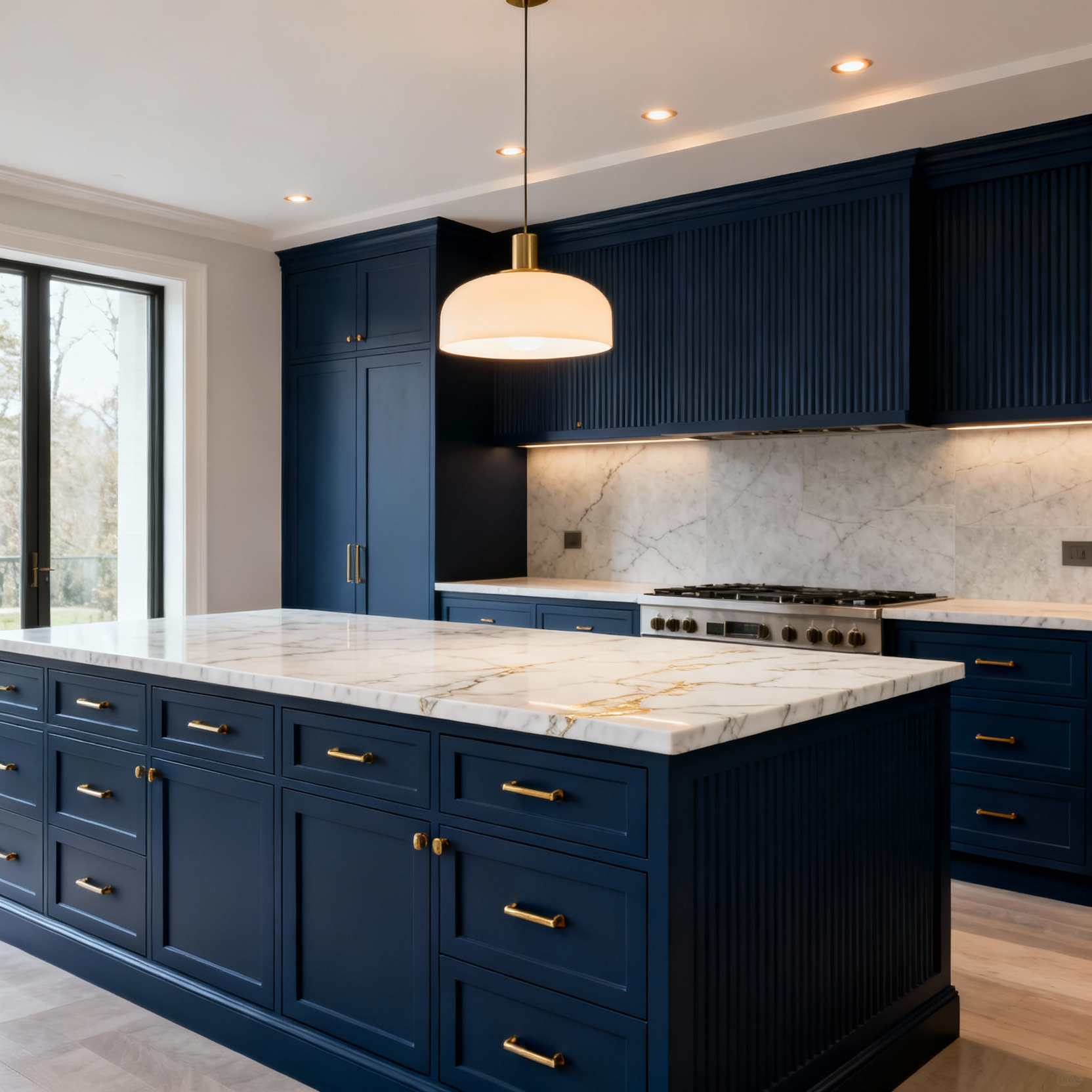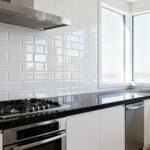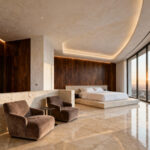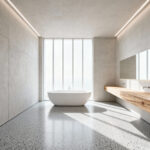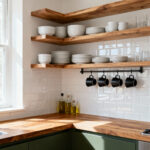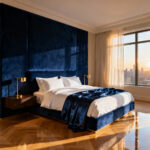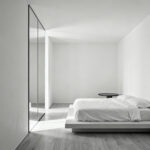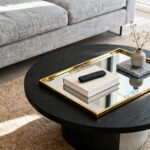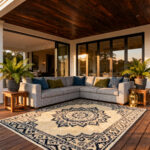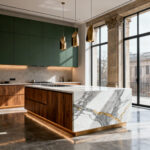We promise your kitchen can be a sanctuary of serene sophistication—these principles of design have mastered the complex balance between chromatic depth and enduring style. After years of designing and observing the world’s most beautiful homes, I have identified the twenty decisions that consistently create blue kitchens resonating with timeless elegance. These aren’t fleeting trends destined to feel dated in a few years; they are foundational choices that represent an investment in a certain quality of life. Blue, in its profound versatility, offers more than just a color; it offers a mood, an atmosphere, and a statement of quiet confidence.
The true allure of blue is not simply a matter of aesthetics. It delves into a much deeper understanding of how color affects us and how materials give that color a voice. It begins with the psychology of a chosen hue—understanding its undertones and how they interact with light—and moves to the tangible world of bespoke cabinetry, veined marble, and hand-pewtered hardware. Only when you master these elements can you create something truly extraordinary.
To guide your journey, this masterclass is organized to move from theory to practical application. We will begin with the conceptual foundations of blue, then explore the symphony of surfaces that bring it to life, and conclude with the strategic orchestration of blue within the kitchen’s architecture. Prepare to discover blue kitchen ideas that promise not just a design upgrade, but a lasting legacy of style.
The Enigmatic Allure of Blue: Philosophical Underpinnings in Culinary Design (Part 1)
Before we select a single material, we must understand the very soul of the color we’re inviting into the heart of the home. This initial exploration goes beyond aesthetics to touch on the inherent qualities of blue—how it can transform a functional room into a sanctuary, a stage for both daily rituals and grand expressions of style. This is about establishing the ‘why’ before the ‘what.’
1. Harnessing Chromatic Psychology: Cultivating Tranquility for Culinary Spaces
In my design practice, I’ve noticed that clients are often drawn to blue for its almost primal sense of calm. Its connection to the vastness of the sky and the depth of the ocean gives it an innate psychological power. A kitchen, so often the energetic center of a home, benefits immensely from this grounding presence. A carefully chosen blue doesn’t just color a room; it alters its emotional temperature, transforming a place of high-energy activity into one of serene efficiency.
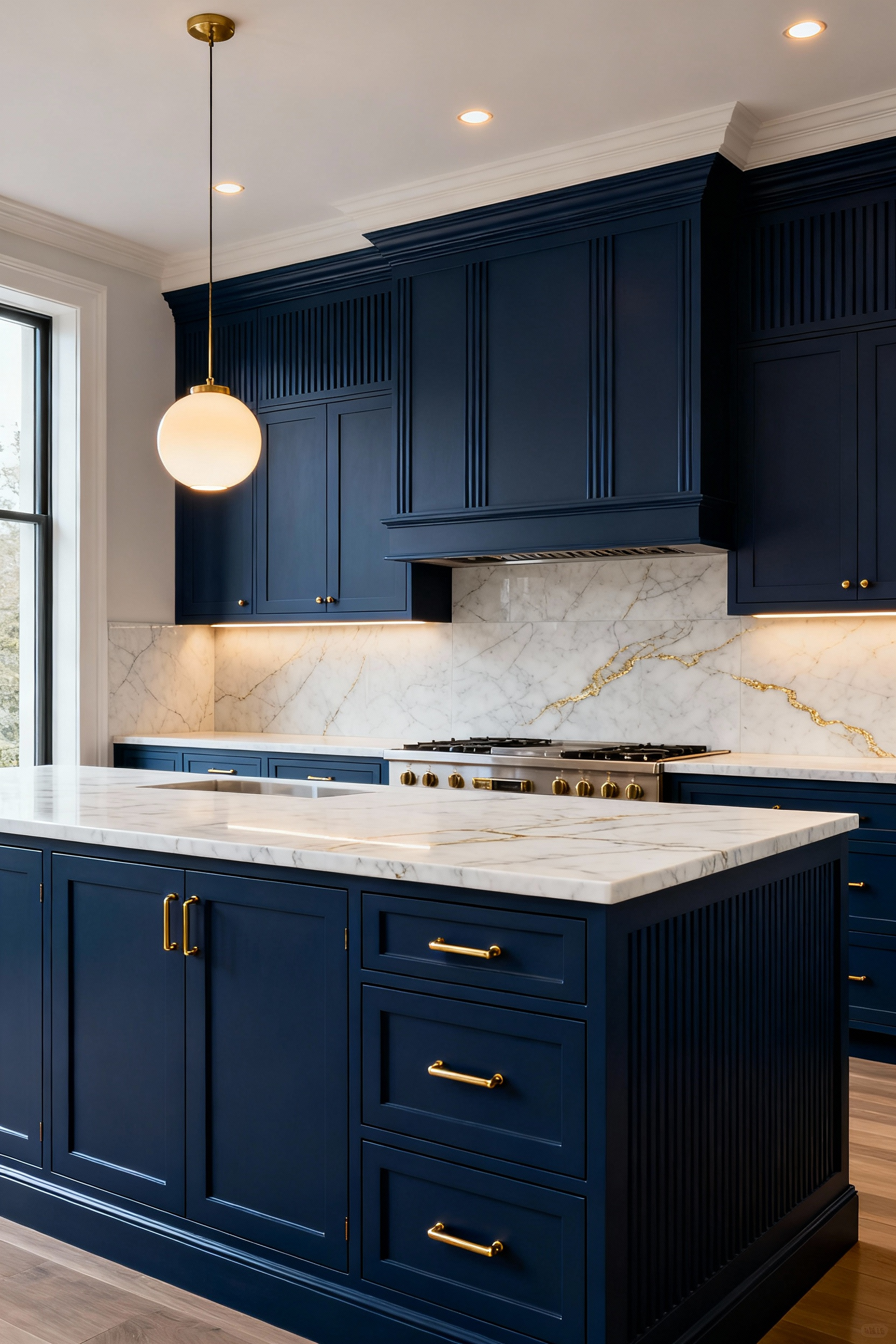
The science supports what designers have always known intuitively. Cool colors like blue can have a calming physiological effect, encouraging the focus required for cooking and the relaxed state desired for gathering. But this isn’t about painting everything a single shade. What I advise my clients is to think about how they want to feel in the space. A soft, sky blue on upper cabinets can make a ceiling feel miles away, while a deep, grounding navy on lower cabinets can create a sense of stability and permanence. The goal is to orchestrate a mood, shaping an experience that begins the moment you walk into the room.
2. Deciphering Undertones: The Nuance of Cool Versus Warm Blues
The difference between a blue kitchen that feels sophisticated and one that feels jarring often comes down to a single, subtle detail: the undertone. A true understanding of color theory taught me that blue is never just blue. Is it a cool blue with hints of grey or green, or a warm blue with a whisper of red? This single decision dictates the entire mood and how the color interacts with light, metals, and stone.
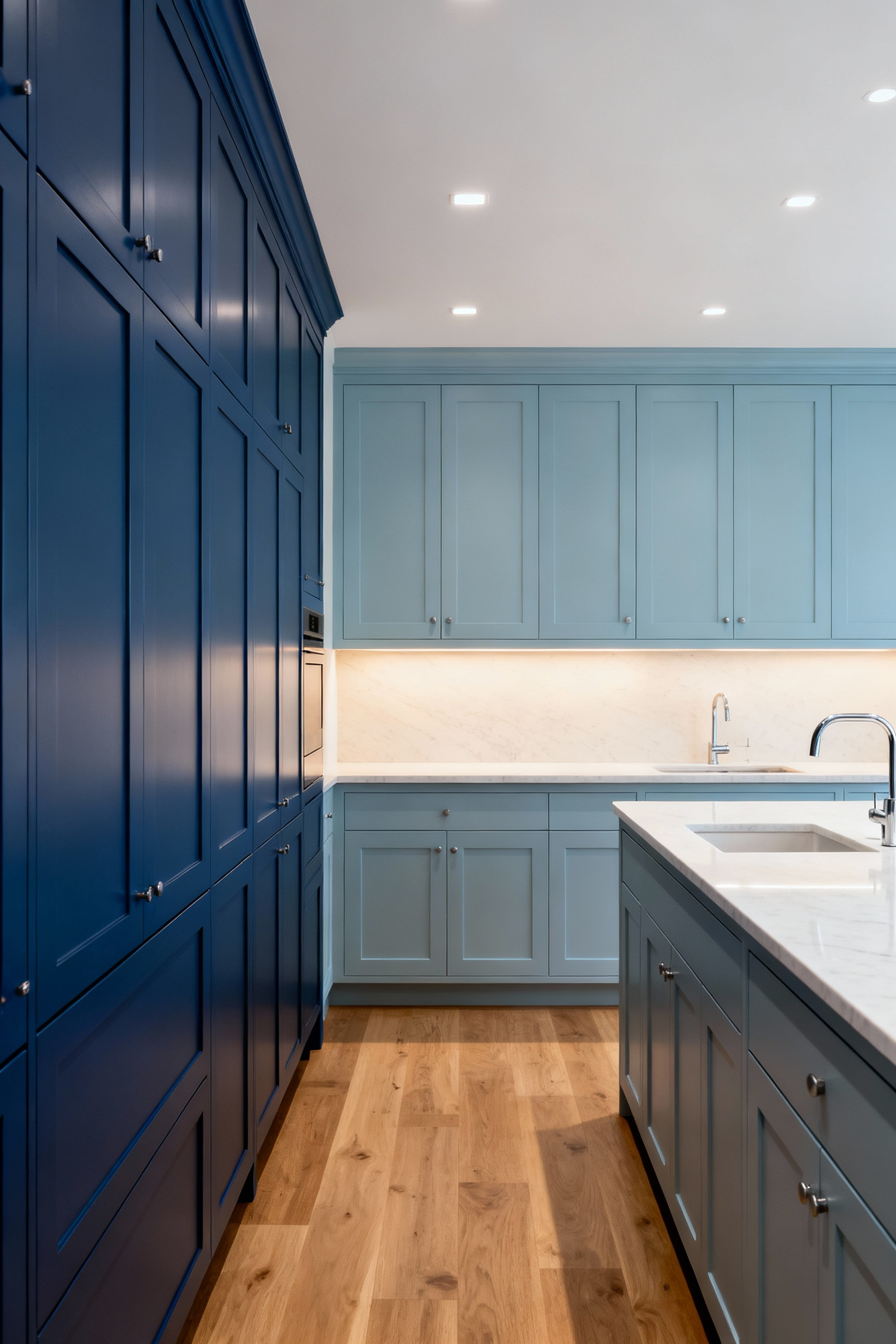
Cool blues, like a crisp periwinkle or a steely slate, tend to visually recede, making a space feel larger and airier. They project a clean, modern confidence and pair beautifully with polished chrome, stainless steel, and stark white marble. Conversely, warmer blues—think of a deep Prussian blue or a soft, aged denim—advance toward you, creating an intimate, enveloping feeling. I find these shades are magnificent with natural woods and the rich patina of unlacquered brass. Choosing the right undertone is the first step in ensuring your kitchen’s palette is a harmonious symphony, not a collection of competing notes.
3. Historical Resonances: Tracing Blue’s Heritage to Modern Interiors
To work with blue is to engage in a conversation with history. For centuries, blue pigments were rare and prized—from the lapis lazuli of Egyptian pharaohs to the precious indigo that built trade empires. Its difficulty to produce cemented its status as a color of royalty and divinity. This rich heritage gives blue an inherent gravitas that other colors simply do not possess. When you choose blue for your kitchen, you are tapping into this deep well of cultural significance.
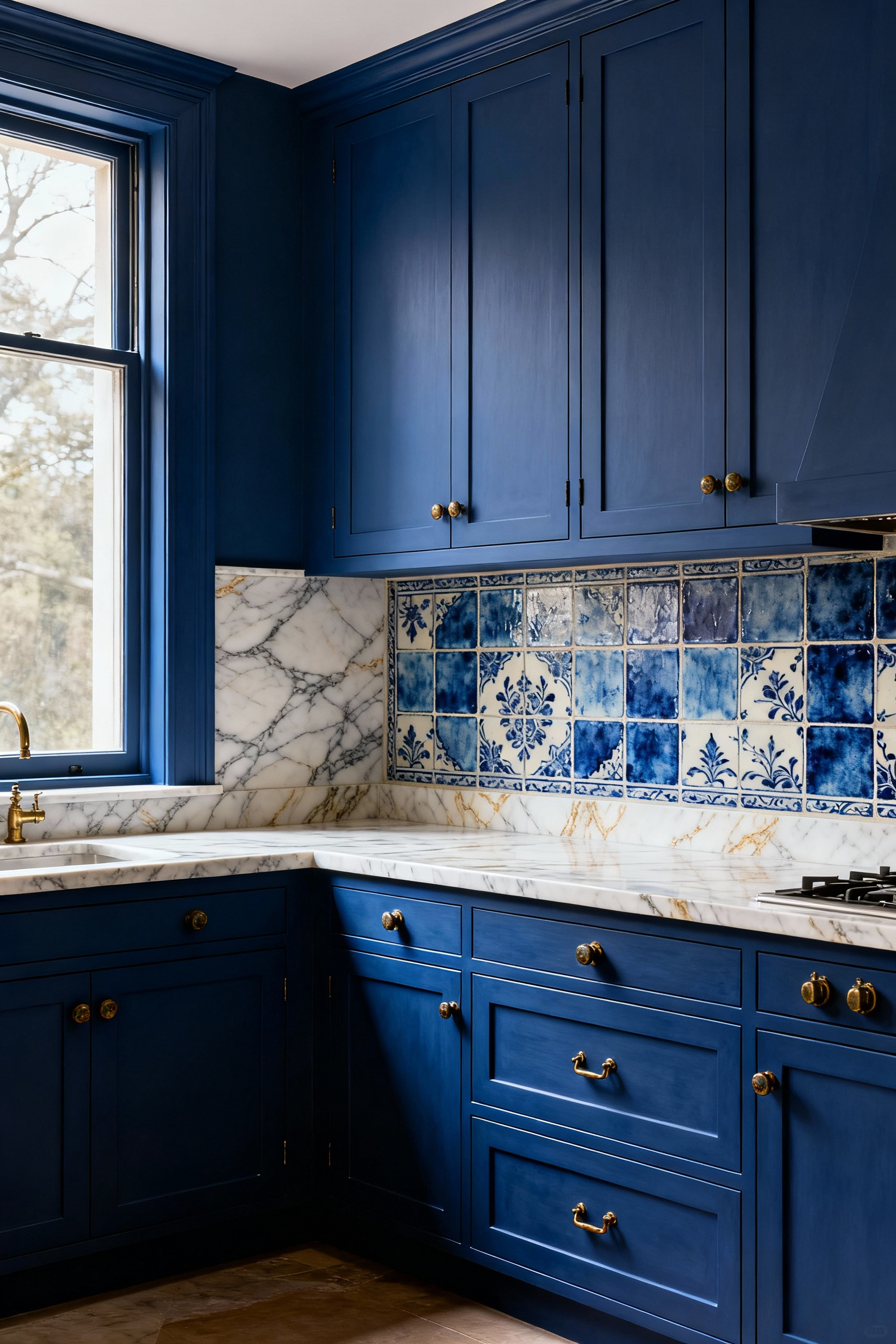
This historical dialogue can inform your design in subtle yet powerful ways. A deep, inky blue on an island can evoke the artisanal quality of hand-dyed textiles or the revered cobalt of antique Delftware. A more vibrant, mid-century blue might carry with it a sense of optimism and progress. From my work in luxury interior design, I’ve learned that referencing these historical notes—whether through the specific shade or its pairing with traditional materials—adds a layer of narrative and depth. Your kitchen becomes more than a beautifully designed space; it becomes a room with a story.
4. Architectural Integration: Making Blue Foundational, Not an Afterthought
The most successful blue kitchens treat the color not as decoration, but as a core Architectural element. This is a critical distinction. Instead of asking, “What wall should we paint blue?” a more sophisticated approach is to ask, “How can blue define the very structure and flow of this space?” When blue is integrated at the conceptual stage, it becomes an intrinsic part of the kitchen’s form.

Consider a bank of floor-to-ceiling cabinetry finished in a deep marine blue. It ceases to be just storage and becomes a monumental feature, an architectural wall that anchors the entire room. I designed a kitchen for a client’s countryside estate where we used this exact approach; the monolithic blue wall served to elegantly separate the primary cooking zone from the more relaxed breakfast area, no partition needed. By making blue a part of the architecture, you ensure the color feels intentional and permanent, a fundamental component of the home’s very bones.
The Enigmatic Allure of Blue: Philosophical Underpinnings in Culinary Design (Part 2)
Building on these foundational ideas, we now explore more refined strategies for wielding blue’s power. This is where we move from broad concepts to the nuanced art of application—orchestrating tonalities and mastering the interplay of light to achieve a truly transcendent result.
5. The ‘Rule of Three’ in Blue Tonalities: Achieving Depth with a Graded Palette
A single shade of blue can be beautiful, but a curated trio of harmonious blues creates a space with extraordinary depth and character. The ‘Rule of Three’ is a timeless design principle, and applying it to a color palette prevents a room from feeling flat or predictable. The idea is to layer a dominant blue with two supporting tones—one secondary and one accent—to create a visual journey that is both cohesive and compelling.
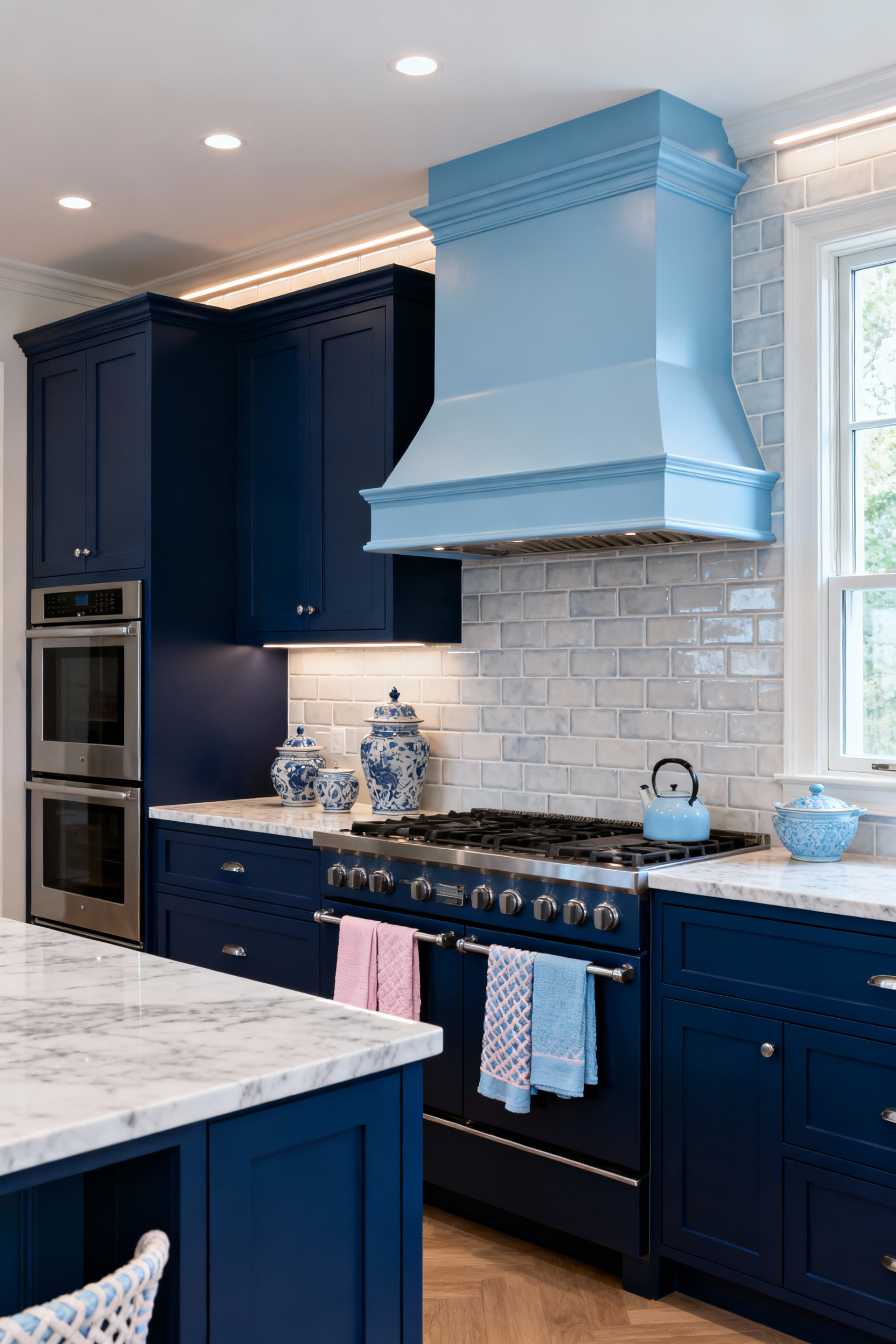
Here’s how this plays out in a real-world application: start with a strong, anchoring blue for the main cabinetry, such as a deep navy. Then, introduce a secondary, mid-tone blue on the island—perhaps a softer, dustier slate blue. The third, and lightest, blue acts as the accent. This could appear in the subtle veining of a quartzite countertop, the pattern of a Roman blind, or in a collection of hand-glazed ceramic vases on an open shelf. This layering of tones creates a sophisticated rhythm and a rich, enveloping atmosphere that a single color could never achieve on its own.
6. Balancing Luminosity: Optimizing Light for a Transcendent Blue Kitchen
Light is the final ingredient in any design recipe, and for a blue kitchen, it is absolutely essential. Blue’s character is profoundly shaped by light. A deep, moody blue can look positively regal in a sun-drenched room but might feel somber and heavy in a space with poor natural light. Mastering a blue kitchen is, in many ways, an exercise in mastering illumination.

The key is a multi-Layered Lighting strategy that marries natural and artificial sources. You start by maximizing daylight with uncluttered windows. Then, you build layers of artificial light: ambient overhead lighting to provide a general glow, focused Task Lighting under cabinets for prep work, and accent lighting to highlight beautiful details. What I always recommend is putting everything on a dimmer. This gives you ultimate control, allowing you to transition the kitchen’s mood from bright and functional for a busy morning to a soft, atmospheric intimacy for an evening gathering. The right light doesn’t just illuminate your blue kitchen; it brings it to life.
A Symphony of Surfaces: Integrating Blue Through Premium Materials and Finishes (Part 1)
A kitchen’s soul is expressed through its surfaces. This is where a design concept becomes a tangible reality. Here, we move into the critical role of premium materials, exploring how the right choices in cabinetry, stone, and tilework can elevate blue from a simple color to a rich, immersive experience.
7. Bespoke Cabinetry: The Power of Lacquer, Matte, and Wood Finishes
The cabinetry is the backbone of your kitchen, and its finish will dictate the entire character of the space. For a bold, contemporary statement, a high-gloss lacquer in a vibrant sapphire or royal blue is magnificent. It creates an almost liquid-like surface that bounces light around the room, making the space feel energetic and expansive. I’ve seen this work wonders in smaller kitchens where maximizing light is crucial.
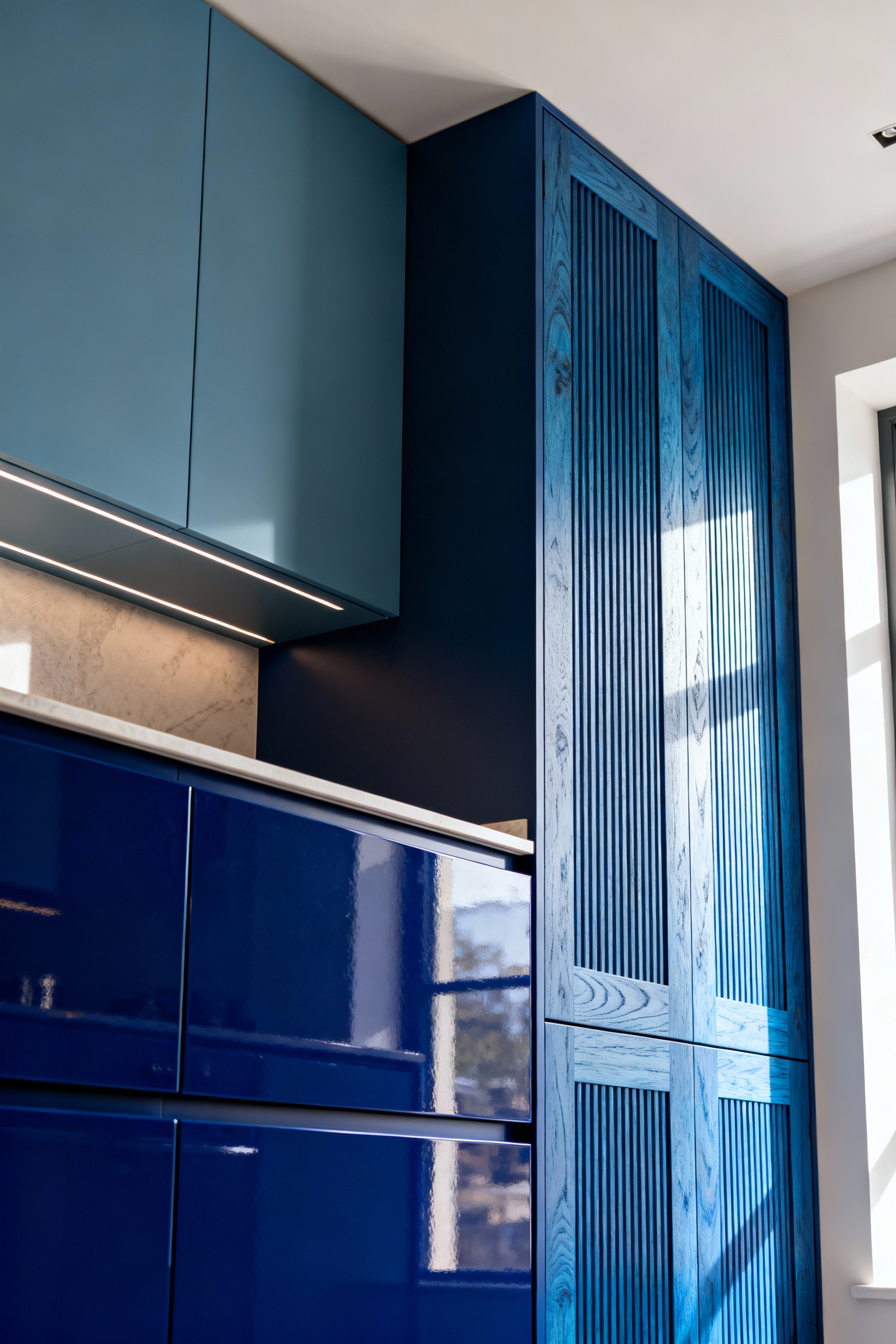
For a quieter, more understated elegance, a super-matte finish is unparalleled. When applied to a deep indigo or a soft grey-blue, a velvety matte surface absorbs light, creating a profound sense of depth and calm. It’s a finish that invites touch. To add warmth and balance, I often introduce a refined wood grain as a counterpoint. Imagine an island clad in natural rift-sawn white oak set against deep navy cabinets. This interplay of reflective, matte, and organic surfaces is the hallmark of a thoughtfully designed space.
8. Precious Stone Interplay: Elevating Blue with Veined Marble and Quartzite
The horizontal planes—your countertops and backsplash—are where you can introduce the breathtaking artistry of natural stone. A beautifully veined stone provides a perfect counterpoint to the solid color of blue cabinetry. The classic choice is, of course, a Calacatta marble with its dramatic grey and gold veining dancing across a creamy white background. It offers a timeless elegance that feels both grand and serene.

However, don’t overlook other options. For a client seeking unparalleled durability without sacrificing beauty, we selected a stunning Cristallo quartzite with subtle blue and grey undertones that echoed the cabinetry perfectly. The stone’s crystalline structure gave it an almost ethereal translucence. For a more dramatic and grounding effect, a honed black soapstone provides a velvety, organic contrast to lighter blues. This careful pairing of a man-made color with a creation of the earth is what brings a sense of permanence and soul to a kitchen.
9. Artisanal Tilework: The Textural Depth of Zellige and Bespoke Ceramics
The backsplash is an opportunity for true artistic expression. Instead of a predictable surface, consider it a canvas. This is where the soulful imperfection of handmade tile can provide a stunning textural counterpoint to the clean lines of cabinetry. Moroccan Zellige tiles, with their slight irregularities and nuanced color variations, are a particular favorite of mine. In a deep indigo or teal, they create a shimmering, dynamic surface that seems to breathe with the changing light.
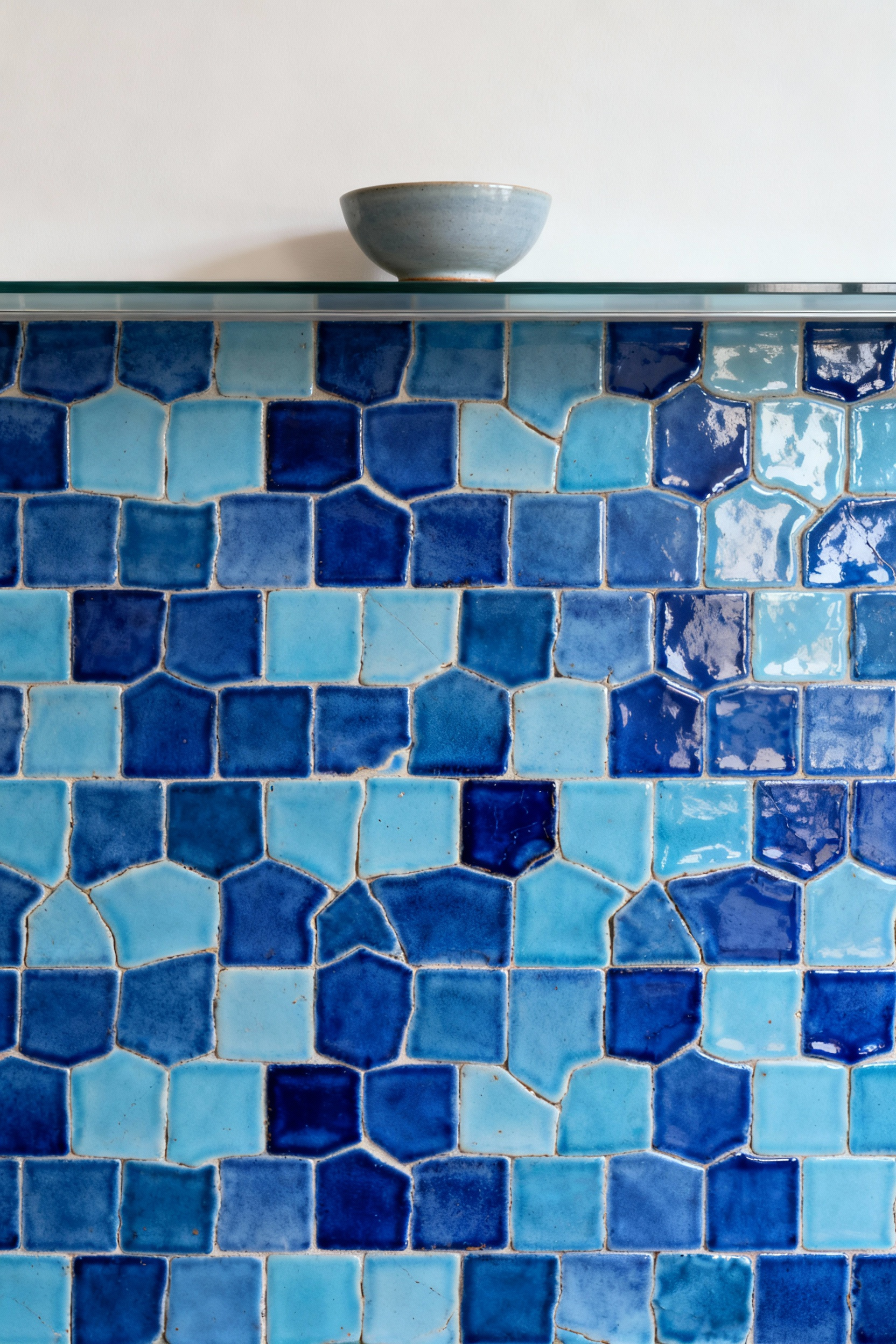
For a more graphic statement, bespoke glazed ceramics offer limitless possibilities. Imagine a feature wall behind the range clad in tiles hand-painted with a delicate motif in cobalt blue. In one project, we used custom-made subway tiles with an intentional crackle glaze in a soft, misty blue; it added a subtle layer of age and character that transformed the entire wall. Embracing the mark of the artisan’s hand is a choice that infuses a kitchen with warmth, history, and a unique personality.
10. Metallic Accents: Orchestrating Interest with Aged Brass and Patinated Finishes
Hardware is the jewelry of the kitchen. It is a detail that should never be an afterthought, as the right metallic accent can unify and elevate the entire design. The choice of metal finish creates a conversation with your chosen shade of blue. Against the coolness of most blues, the warmth of aged brass is simply spectacular. It develops a rich patina over time, a “living finish” that tells a story and adds a layer of heritage and soul to the space.
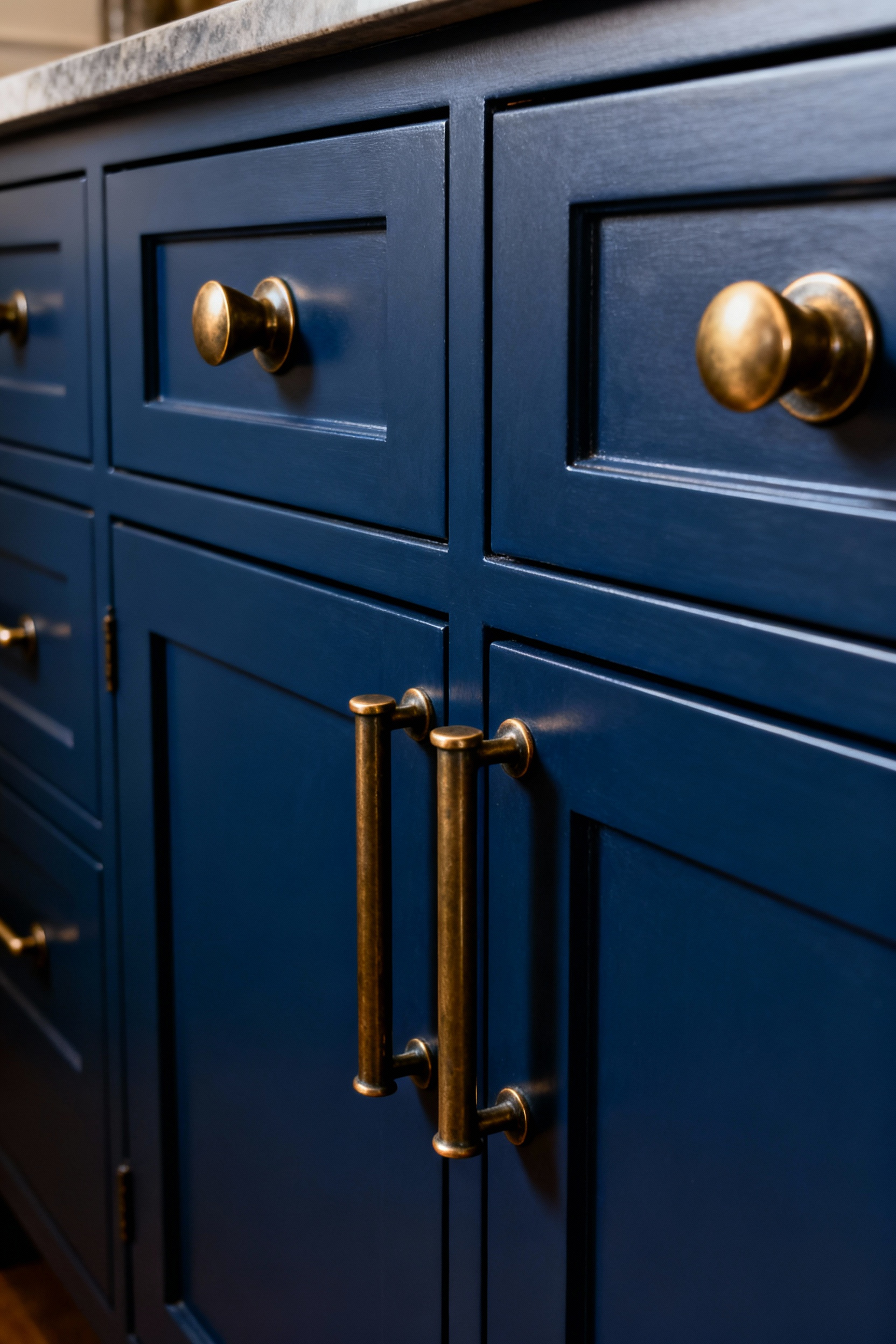
For a more understated or industrial feel, a patinated bronze or a hand-pewtered hardware can provide a soft, muted counterpoint. Polished nickel offers a crisp, classic feel, while matte black provides a strong, graphic edge for a more modern aesthetic. Remember to extend this thinking beyond just cabinet pulls. Your faucet, light fixtures, and even shelving brackets should all be part of this cohesive metallic narrative. It’s these final, thoughtful touches that signal a truly curated and luxurious design.
A Symphony of Surfaces: Integrating Blue Through Premium Materials and Finishes (Part 2)
Building upon the foundational surfaces, we now delve into materials that add layers of nuanced artistry and high-performance practicality. These are the choices that demonstrate a deeper level of design thinking, where even functional items become integral to the aesthetic vision, creating a kitchen that is as intelligent as it is beautiful.
11. Hand-Glazed Ceramics: Functional Art as a Tonal Extension
Why should beauty be confined to the fixed elements of a kitchen? The concept of extending the design narrative to the objects we use every day is central to a holistic lifestyle. I encourage clients to think of their curated dinnerware, serving bowls, and vases not as clutter, but as functional art that continues the color story. Displaying a collection of hand-glazed ceramics on open shelving or behind glass-front cabinets becomes a deliberate act of styling.
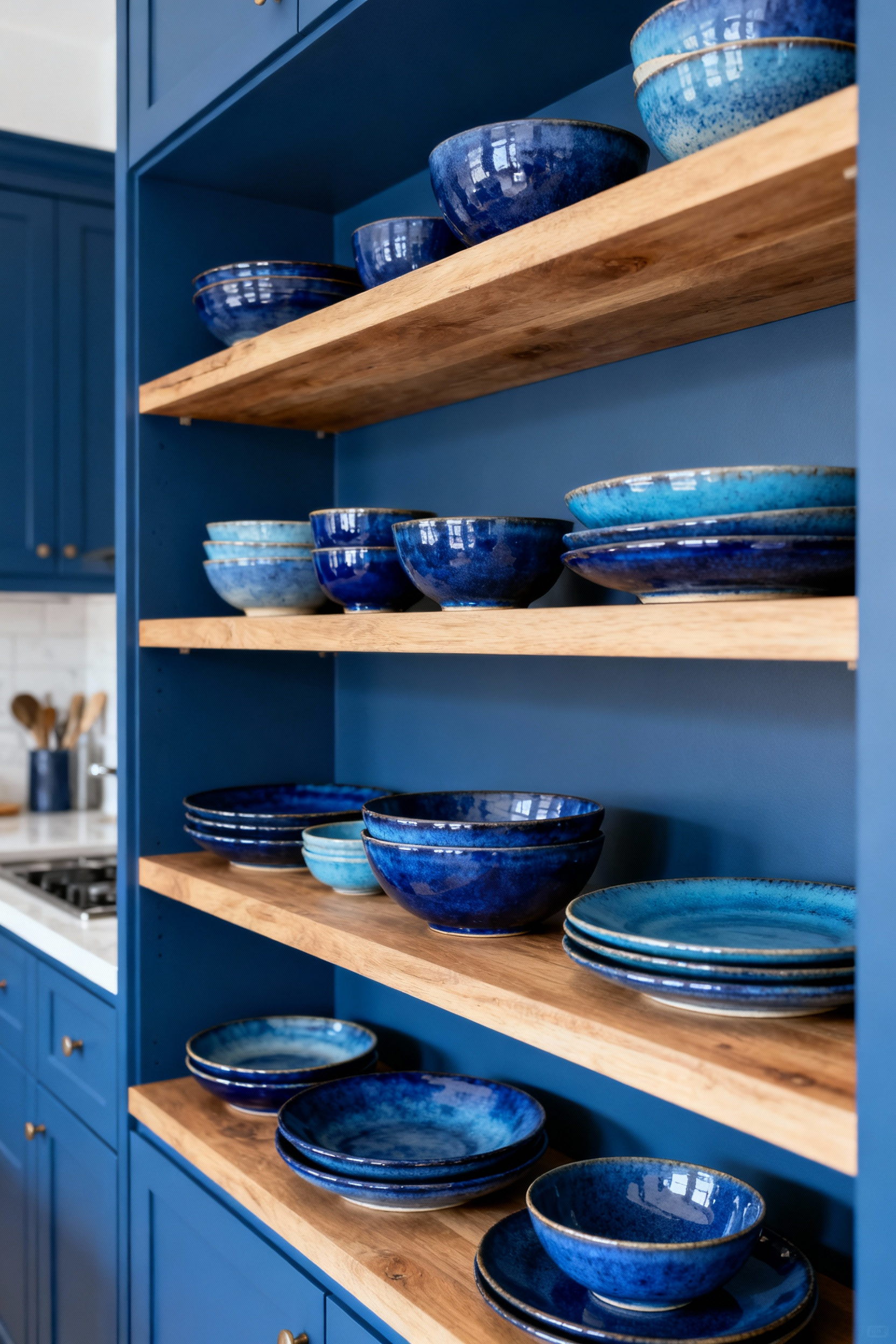
The artisanal process behind these pieces—the slight variations in a deep indigo glaze, the subtle crazing on a pale celadon bowl—introduces an organic, human element. Imagine a set of deep blue stoneware plates stacked neatly against a white shiplap wall; they provide a pop of saturated color and texture. This approach ensures the kitchen feels alive and personal. It’s a testament to a life well-lived, where beauty is found in daily rituals.
12. Architectural Glass: Fluted, Reeded, or Back-Painted Blue Panels
Glass, when used architecturally, is a master of manipulating light and perception. For a blue kitchen, it offers a sophisticated way to introduce color and texture without adding visual weight. Fluted or reeded glass inserts in upper cabinet doors are a personal favorite. They obscure the contents just enough to maintain an uncluttered look while creating a beautiful play of light and shadow, hinting at the silhouettes within. It’s a nod to classic design that feels entirely fresh.

For a more modern and dramatic statement, back-painted glass is a superb choice for a backsplash or even an island face. A sheet of glass, painted on the reverse in a deep, glossy navy or a vibrant cerulean, creates a seamless, monolithic plane of pure color. Its reflective quality amplifies light and space, and it’s remarkably easy to clean. Using architectural glass is an intelligent way to add another layer of luminosity and refined detail to your blue kitchen.
13. Engineered Composites: Precision and Durability in Deep Pigmentation
While my heart often lies with natural materials, the technological advancements in engineered composites are too remarkable to ignore. Brands like Dekton or Caesarstone offer ultra-compact surfaces that provide unparalleled performance, making them an incredibly smart investment for a hard-working kitchen. These materials are virtually indestructible—resistant to heat, scratches, and stains—offering a peace of mind that is its own form of luxury.
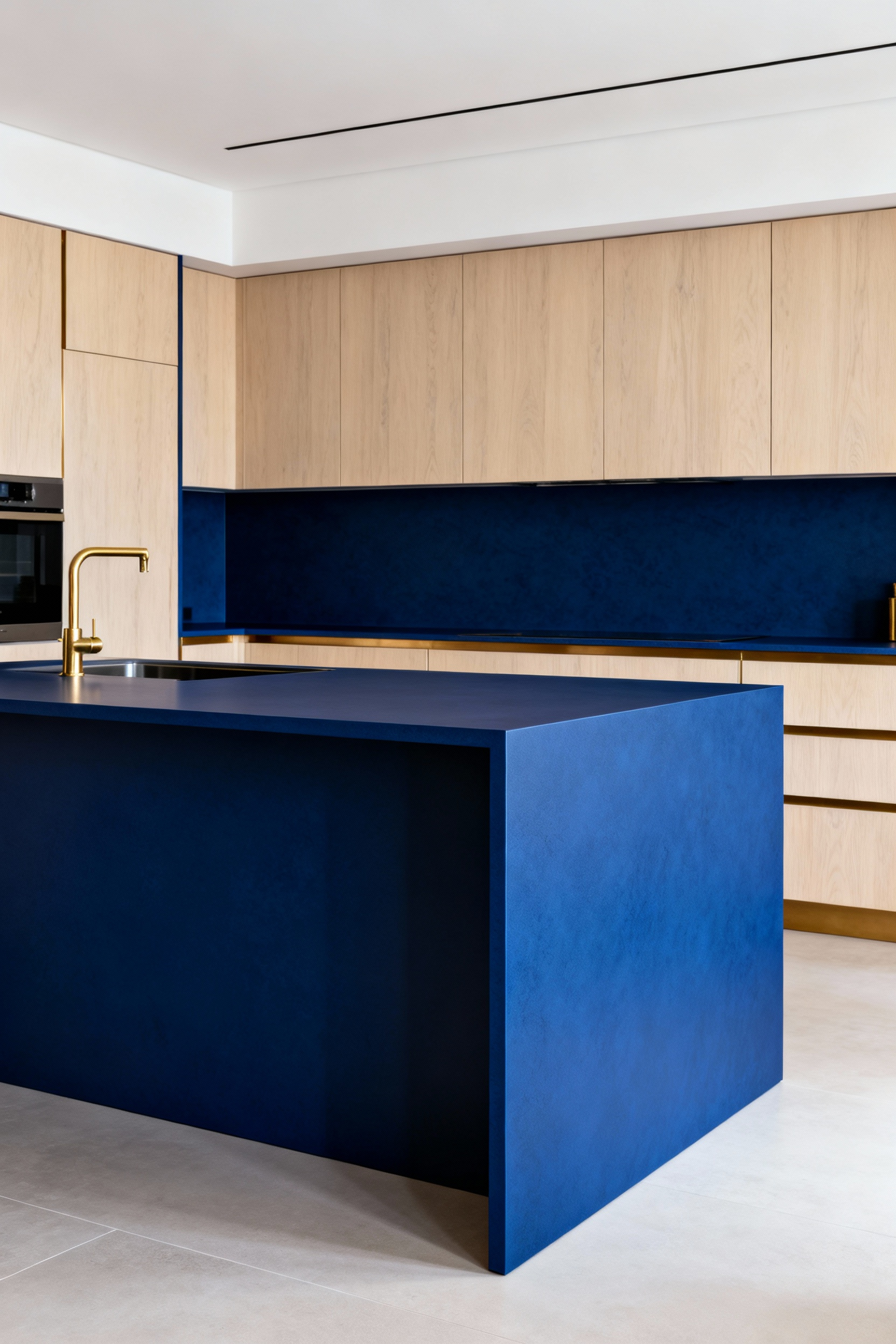
What is particularly exciting for blue kitchen ideas is the precision of their pigmentation. You can achieve a perfectly consistent, deeply saturated shade of blue that would be impossible to find in natural stone. A waterfall island clad in a velvety matte navy composite creates a stunning, sculptural centerpiece that is both beautiful and bulletproof. It’s the perfect marriage of cutting-edge innovation and timeless design, allowing you to embrace a bold color without compromising on function.
Orchestrating Space: Strategic Application of Blue Within the Culinary Arena (Part 1)
With our materials chosen, we now turn to their placement. This is the strategic orchestration of design, where we use blue not just as a color, but as a tool to define zones, create focal points, and shape the very experience of moving through the space. This is where blue becomes an active participant in the kitchen’s architecture.
14. The Monolithic Statement Island: A Blue Hub for Culinary Interaction
The kitchen island is more than a workspace; it is the modern-day hearth, the gravitational center of the home where everyone gathers. Designing this central hub in a commanding shade of blue is a powerful statement. It immediately establishes the island as the aesthetic and social anchor of the room. A large-scale island in a deep blue can single-handedly define the kitchen’s layout, delineating work zones from social spaces without walls.
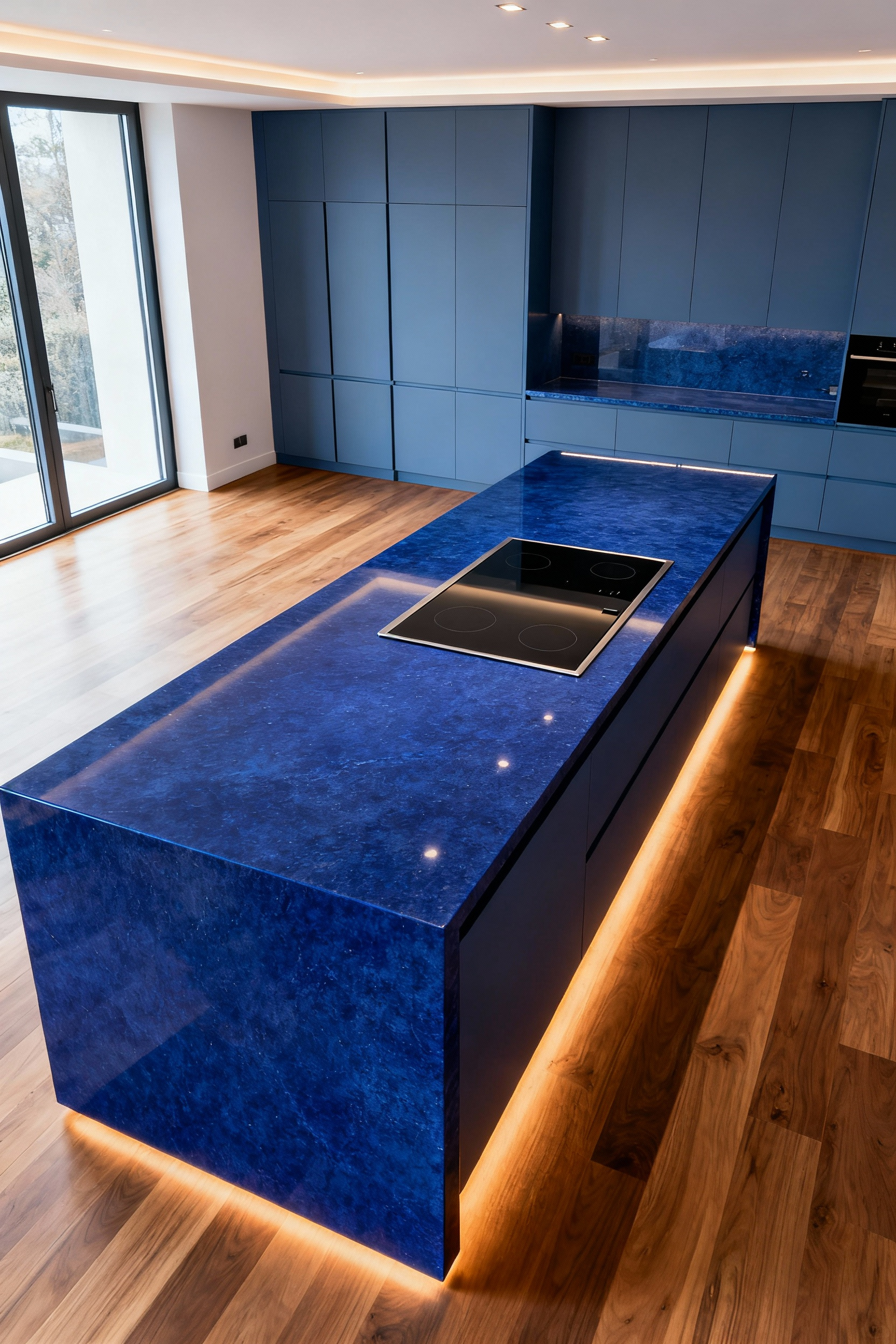
Imagine an island painted in a rich Farrow & Ball ‘Hague Blue’, topped with a thick slab of Calacatta marble, its warm veining providing a beautiful contrast. Its sheer presence provides a visual weight that grounds the entire room. This is a design choice that speaks to a lifestyle of gathering and entertaining. The blue island becomes the stage for daily life—from morning coffee and homework sessions to serving cocktails and hors d’oeuvres during a party.
15. Beyond the Perimeter: Integrating Paneled Blue Appliances for a Seamless Look
There is a particular kind of quiet luxury that comes from a seamless, integrated aesthetic. Hiding appliances behind custom panels that match your blue cabinetry is a masterstroke of sophisticated design. It allows the utilitarian nature of refrigerators and dishwashers to disappear, resulting in an uncluttered, continuous visual plane that reads more like bespoke furniture than a functional kitchen.

This is especially effective with a strong color like blue. Without the interruption of stainless steel or black glass, the eye can sweep across a serene expanse of cabinetry, making the room feel larger and more tranquil. I always specify panel-ready appliances from brands like Sub-Zero or Miele for high-end projects. The result is an elevated, architectural feel where every element is in perfect harmony. It’s a subtle but powerful detail that signals an unwavering commitment to refined design.
16. Backsplash as Art Installation: Bespoke Blue Tiling or a Book-Matched Slab
Treating the backsplash as an art installation is one of my favorite ways to create a powerful focal point. This is your chance to be bold. Instead of a simple surface, envision a full-height wall of hand-painted Majolica tiles, their vibrant blue patterns telling a story. Or, for a truly show-stopping moment, a book-matched slab of blue-veined marble or quartzite creates a geological masterpiece.
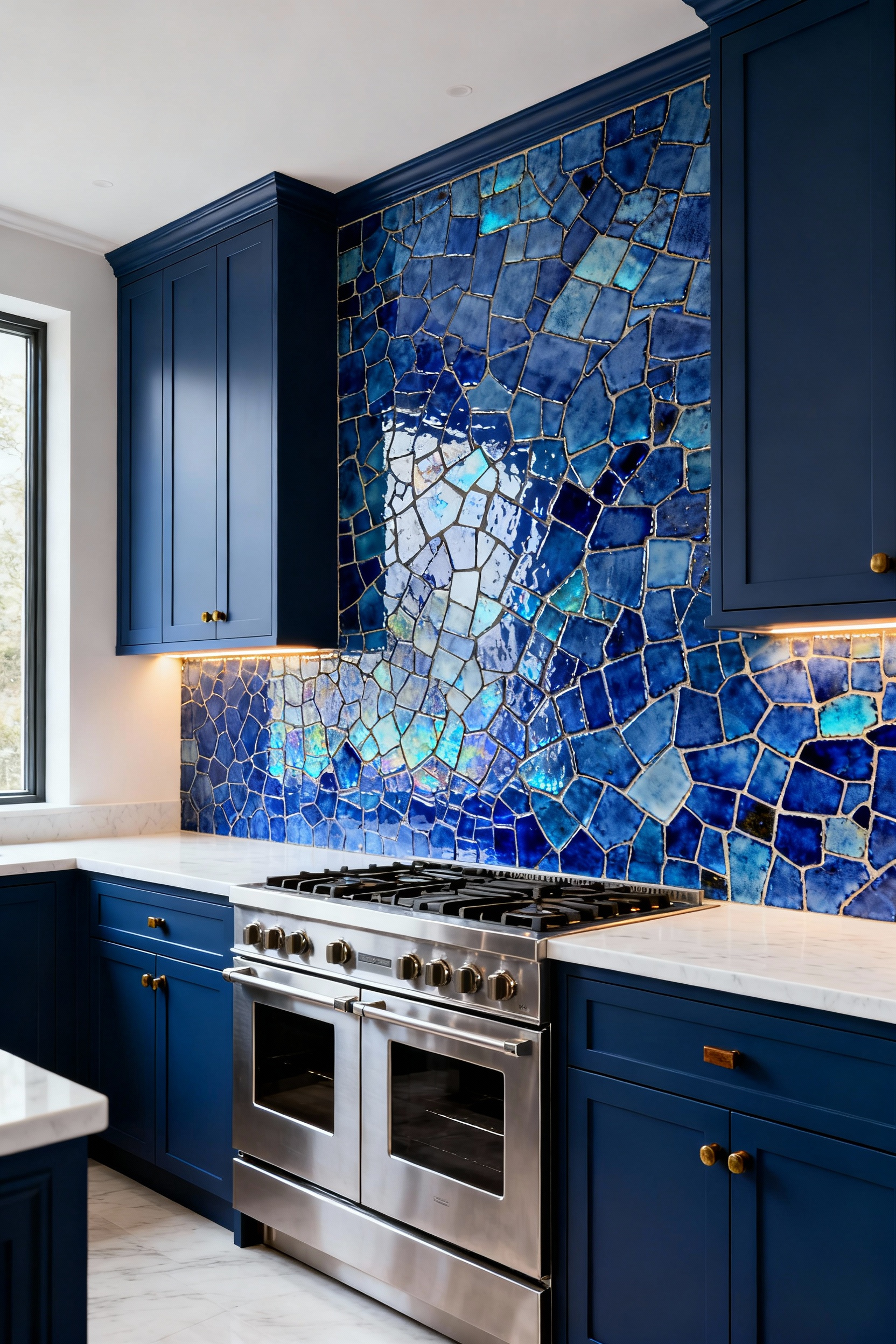
I once worked on a coastal home where we used a slab of Sodalite—a breathtakingly deep blue stone with white veining—for the backsplash behind the range. It became the undeniable centerpiece of the entire open-plan living area. This approach transforms a utilitarian surface into a source of daily inspiration and beauty. It declares that even the most functional parts of a home deserve to be exceptional.
17. The Understated Pantry: Deep Blue as a Luxurious, Hidden Sanctuary
Some of the most delightful design moments are the hidden ones. I adore the concept of a pantry that, when opened, reveals a jewel-box interior. Painting the inside of a pantry—the shelving, the walls, the back of the door—in a deep, moody shade of blue creates an unexpected and luxurious surprise. It transforms a purely functional storage space into a small, curated sanctuary.

Imagine a walk-in pantry where everything is enveloped in a rich, velvety Prussian blue, illuminated by a single, warm spotlight. Suddenly, the simple act of retrieving flour or spices feels special. It’s an expression of what I call “private luxury”—a detail done not for show, but for one’s own enjoyment. It demonstrates a commitment to thoughtful design that extends into every corner of the home, a hallmark of true elegance.
Orchestrating Space: Strategic Application of Blue Within the Culinary Arena (Part 2)
Our final exploration delves into the more subtle yet profoundly impactful ways blue can shape a space. Here we look at how blue interacts with the vertical dimension of a room, the softness of textiles, and the transformative power of light to create a truly immersive and sophisticated culinary environment.
18. Verticality in Design: Extending Blue Cabinetry to Ceiling Height
To create a sense of grandeur and architectural integrity, I often extend cabinetry all the way to the ceiling. When done in blue, this creates a powerful, unbroken vertical plane that draws the eye upward, making the room feel significantly taller and more spacious. It’s a technique that turns a wall of storage into a commanding architectural statement.
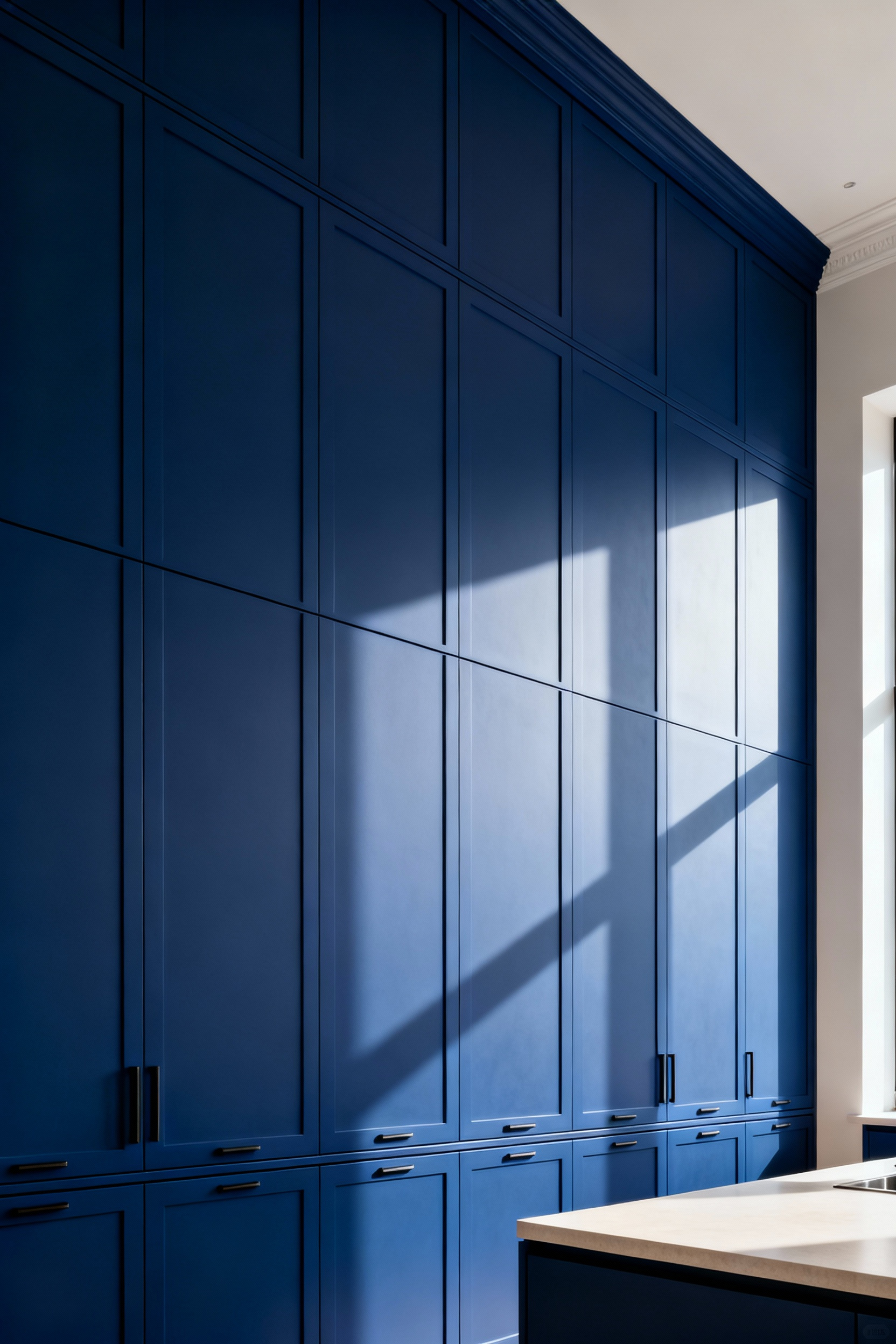
This approach eliminates the awkward, dust-collecting space above standard cabinets and creates a clean, intentional line. A floor-to-ceiling bank of deep navy cabinets can feel as solid and permanent as the walls themselves, lending the room an air of bespoke quality. In a smaller kitchen, this can paradoxically make the space feel larger by creating a monolithic, uninterrupted surface. It’s a bold choice that results in a cohesive and dramatically elegant look.
19. Layering Textural Linens: Performance Fabrics and Custom Window Treatments
A beautifully designed kitchen must appeal to the sense of touch as well as sight. This is where textiles come in. Layering in soft elements like upholstered bar stools, a custom Roman blind, or a plush banquette cushion is essential for creating warmth and preventing a space from feeling too hard-edged. For a blue kitchen, this is an opportunity to introduce complementary tones and textures.

I always specify high-performance fabrics in a culinary setting to ensure durability and stain resistance. A beautiful woven fabric with threads of navy, slate, and cream for a window treatment can tie the whole palette together while softening the light. A banquette upholstered in a rich blue performance velvet adds a touch of luxurious comfort. These tactile layers are what make a kitchen feel like a truly inviting and livable heart of the home.
20. Illuminated Blue: Integrated Lighting to Enhance Tone and Depth
The final touch in orchestrating your space is light. And more specifically, integrated lighting that is designed to enhance your chosen blue. Under-cabinet LED strips are non-negotiable; they provide essential task lighting while beautifully illuminating your countertop and backsplash. I learned early in my career that good lighting can make or break a kitchen. It’s that important.
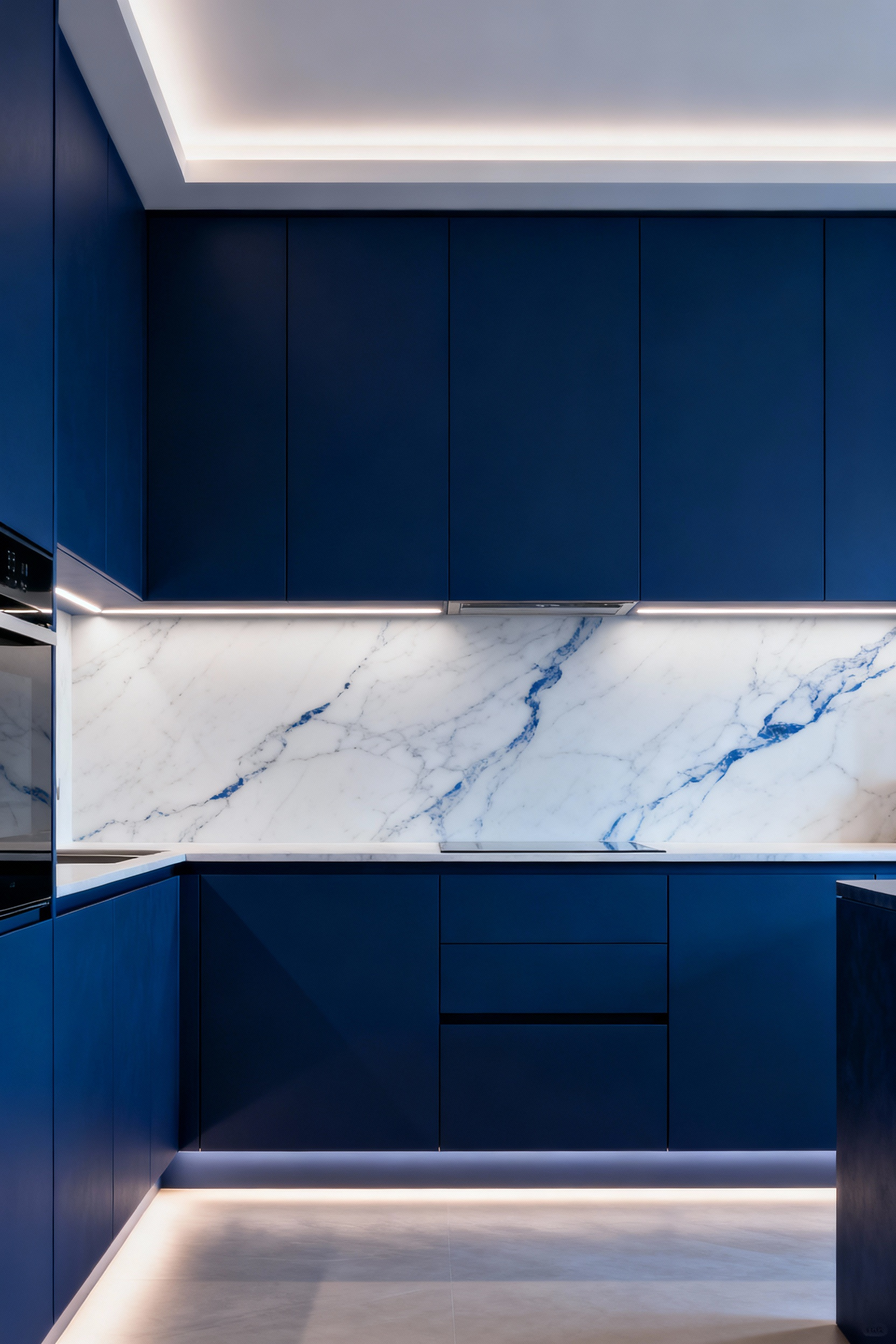
Think beyond the basics. Concealed lighting on top of tall cabinets can cast a gentle, ambient glow towards the ceiling, enhancing the sense of height. Interior lighting inside glass-fronted cabinets transforms your glassware into a sparkling display. Toe-kick lighting under an island can create a dramatic floating effect, especially striking with a dark blue island. Each layer of light is designed to sculpt the space, highlight the beauty of the blue, and create an atmosphere that is both functional and magical.
Conclusion
Our journey through these twenty curated blue kitchen ideas confirms a truth I have long held in my practice: blue is a color of remarkable depth, versatility, and timeless elegance. We have seen how it can be bold and architectural, soft and serene, traditional and strikingly modern. From the crucial choice of undertone to the final placement of a brass pull, each decision contributes to a kitchen that is far more than the sum of its parts.
What becomes clear is that a successful blue kitchen is never about simply following a trend. It is about a thoughtful and strategic application of color theory, material science, and spatial awareness. The most enduring spaces are those where blue is integrated as a foundational element, creating an atmosphere that is both visually captivating and emotionally resonant. Blue provides a sophisticated backdrop for life, promising a sense of calm and collected style for years to come.
As you consider your own project, I encourage you to use these principles not as strict rules, but as a guide to making confident, informed choices. Trust in the power of this classic hue to create a kitchen that is not only beautiful but a true reflection of a refined and thoughtful lifestyle. When you commit to a well-designed blue kitchen, you are investing in an environment of enduring grace and functional poise.
